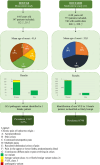Prevalence of Fabry disease in patients with chronic pain: Lessons from the DOUFAB and DOUFABIS studies
- PMID: 39099234
- PMCID: PMC11609957
- DOI: 10.1002/ejp.4708
Prevalence of Fabry disease in patients with chronic pain: Lessons from the DOUFAB and DOUFABIS studies
Abstract
Background: Fabry disease (FD) is a rare X-linked lysosomal disorder caused by alpha-galactosidase deficiency consecutive to a pathogenic variant in the GLA gene. Age at onset is highly variable, with a wide clinical spectrum including frequent renal, cardiac, skin and nervous system manifestations. Since pain can be an indicator of underlying FD, we wanted to estimate the prevalence of FD in a population of chronic pain patients.
Methods: Two studies, DOUFAB and DOUFABIS, were carried out in expert centers for chronic pain to assess the prevalence of FD by measuring alpha galactosidase A activity in men and analysing the GLA gene in women.
Results: Analysis of 893 patients, essentially adults, led to the diagnosis of FD in one female patient, now treated with enzyme replacement therapy.
Conclusions: The prevalence of FD is estimated about 1/1000 in our population of men and women suffering from various chronic pain. This is nearly the prevalence of FD observed in other previously screened high-risk populations with renal failure.
Significance: Although a systematic search for FD does not seem relevant in the context of unexplained chronic pain in adults, a positive family history of FD or the presence of additional FD related organ features must lead to consider this rare disease diagnosis. Therefore, pain specialists need to be aware of main features of FD, including pain characteristics.
© 2024 The Author(s). European Journal of Pain published by John Wiley & Sons Ltd on behalf of European Pain Federation ‐ EFIC ®.
Conflict of interest statement
I.C. received financial support for research activity from Sanofi. C.G. received consulting fees from Sanofi and Amicus; honoraria from Takeda, Sanofi, Amicus and Chiesi for participation in an advisory board, and for lectures; financial support for research activities from TKT5S, Shire, Sanofi and inscriptions and travels for congresses were funded by Shire, Sanofi, Takeda, Amicus and Chiesi. D.P.G. is a consultant for Chiesi, Sanofi and Takeda. Others: No conflict of interest. None of the above relationships influenced the conduct of the present study.
Figures
References
-
- Eng, C. M. , Fletcher, J. , Wilcox, W. R. , Waldek, S. , Scott, C. R. , Sillence, D. O. , Breunig, F. , Charrow, J. , Germain, D. P. , Nicholls, K. , & Banikazemi, M. (2007). Fabry disease: Baseline medical characteristics of a cohort of 1765 males and females in the Fabry Registry. Journal of Inherited Metabolic Disease, 30(2), 184–192. 10.1007/s10545-007-0521-2 - DOI - PubMed
MeSH terms
Substances
LinkOut - more resources
Full Text Sources
Medical


